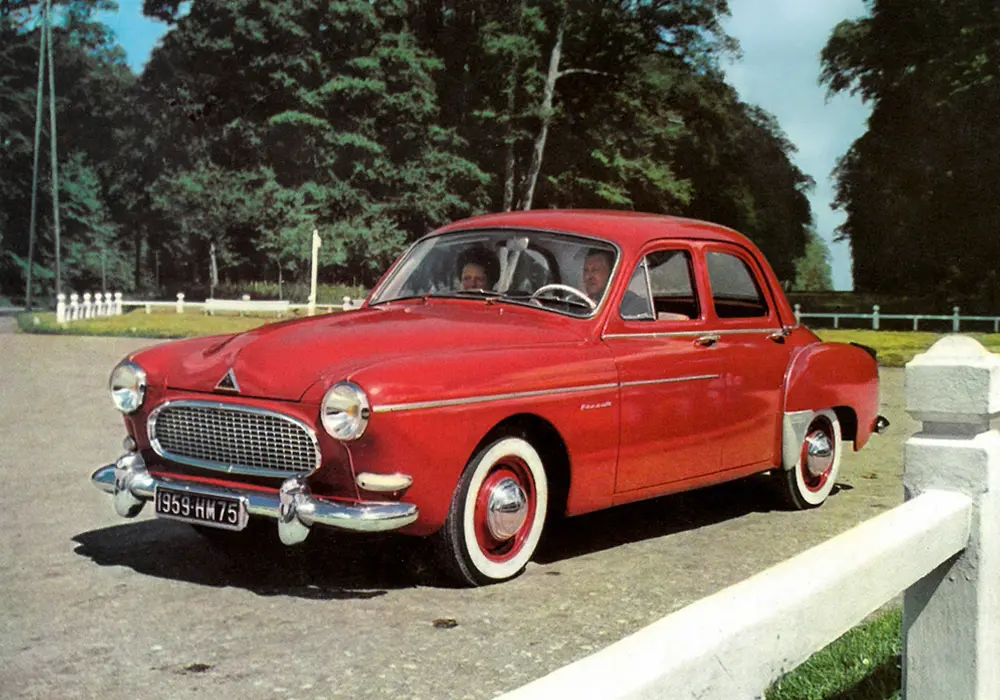The Story of the Renault Frégate
30 September 2021
The Frégate is more likely seen in vintage brochures than on the road, but it was more than a footnote in Renault‘s history. Firstly, it was their first post-war large car, and secondly, its styling inspired the Dauphine.
After the Second World War, Renault’s staple product was the 4CV, but their dealers wished for a larger car to compete with the Citroën Traction Avant. La Regie unveiled the Frégate at the 1950 Paris Motor Show, but the timing of its launch was problematic, to put it mildly. In October of that year, the Minister of Defence had informed the company’s chairman Pierre Lefaucheux of a ban on introducing new models from the 1st January 1951 onwards. The reason was the French government planned to requisition the Flins plant to cope with the military demands of Korea and Indochina.

As a result, the Frégate’s launch was somewhat rushed, as Renault hoped a positive public reaction would cause the government to abandon its scheme. Meanwhile, the handful of pioneer models suffered from body vibrations and a 2 Litre ‘Big Four’ engine with a vast appetite for oil. So it would have been logical to delay full production until 1952, but press comments about the ‘missing’ flagship promoted a virtual re-launch at the 1951 Paris Motor Show.
And the Frégate had much to commend on paper; a well-proportioned six-seater, with all-independent suspension. However, the engine proved inadequate for such a large car, while owners found the four-speed steering column gear change somewhat imprecise. Such issues marred what was fundamentally a very promising vehicle; comfortable and good looking with excellent brakes and highly respectable road manners.
Across The Channel, Bill Boddy thought the Frégate looked like “a handsome American car robbed of its ornate exterior ornaments and, in fact, is nearly as roomy, it handles very nicely and goes remarkably well on a swept volume of only 1,996cc”. However, by 1954, the Frégate was competing with the Simca Vedette for the ‘Nouveau Riche’ market, and the following year saw the introduction of two very significant new rivals.
The Peugeot 403 was slightly smaller and powered by a 1.5-litre engine but almost as spacious as the Renault and superbly engineered. To make matters worse for La Regie, Citroën unveiled the marvel that was the DS. The following year the Frégate was available with 2,141cc power and two new guises; the top of the range Grand Pavois and the Domaine Estate. Alas, sales did not revive.
By the late 1950s, the Frégate’s primary customer base appeared to be government departments. It was also available in the UK, but import duties inflated the price of a Grand Pavois with the optional Transfluide automatic transmission to £1, 542 12s. Production ended on the 18th April 1960, and in November of 1961, it was belatedly replaced by the ‘Renault Rambler’; aka a Belgian assembled Classic Six. Unfortunately, respectable French motorists regarded it with the same suspicion they regarded Johnny Hallyday records.
Renault would not make another in-house executive car until 1975 but the 30 was a completely different machine; five doors, FWD and svelte rather than formal. As for the Frégate, it is a car best seen in black & white French film noir, cruising though the 5th Arrondissement of Paris at night. Or in this splendid cinema advert in which one gentleman demonstrates an unorthodox approach to holiday travel:
